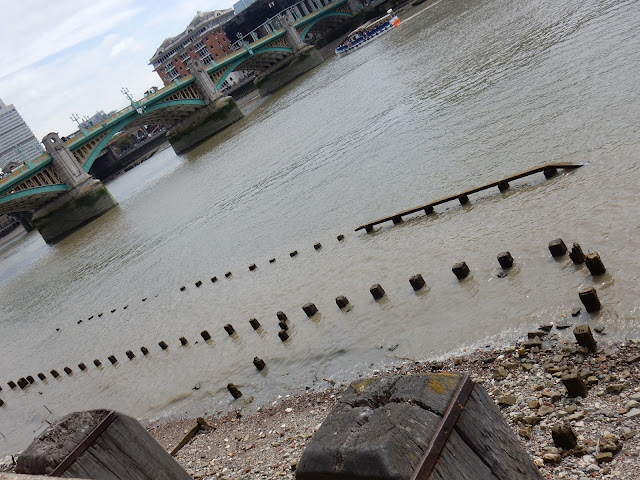We have taken it a little easier to give the feet a bit of a rest. In the morning we walked a little south to visit an lovely old lady who had generously donated some artifacts, pictures and paintings to another interest of mine United Towing and Salvage Society that we have set up. She is very interesting and interested so conversation flowed much longer than I expected. After leaving here to her lunch we wandered down to the Guildhall to look at an exhibition there.
Our route took us over Holborn Viaduct that was one of the first flyovers in the country. It was built to make the route to the City from the West End easier. It was built between 1863 and 1869 sand was coordinated with many other road and street improvements in the area. It was opened by Queen Victoria by a coach trip over it and the other road improvements. In the past the carriages had to descend into the valley of the Fleet River and cross it via a much smaller Holborn Bridge.
The parapets had broze sculptures on them. On the south side were Commerce and Agriculture by Henry Bursill and on the north side these two statues of Fine and Science by sculptor firm Farmer and Brindley.
At each corner of the viaduct were four 'pavillions' that housed the pedestrian access from the level below. Each had a statue of a former Mayor of London. The south eastern corner has Sir Thomas Gresham. During WWII heavy bombing destroyed the pavilions on the north side and they were not replaced until 2014.
We had our lunch in the courtyard of the Guildhall before entering to find that the exhibitions were wanted to see start next week. Never the less we spent time looking round the wonderful, largely Victorian paintings about various aspects of life. Outside the entrance to the Art Gallery I saw a bust of Shakespeare and this one of Christopher Wren. The old building that housed the art collection of the City of London was bombed in 1941. This building was opened in 1999.
From the Guildhall we walked down Ironmonger Lane that has been in the same place with the same name since the 12th Century. It was originally the area of ironmongers but by the 16th century it had moved nearby to Thames Street. Thomas Becket was supposed to have been born on the corner of Ironmongers Lane and Cheapside. I just loved the slight curve and arches of the street.
We made it to the Thames at low water. I had often noticed these piles along the river bank and had assumed that they were just fortifications to protect the sea wall. At Queenhithe Wharf a plaque told me that they are barge beds and were designed to form a level area for barges to rest on over the low tides.
The Tate Modern makes a great backdrop to the Millenium Bridge. The Tate Modern is built in the old Bankside Power Station which was built in two period between 1947 and 1963 and closed in 1981. The Millenium Bridge it was started in 1998 and opened in 2000. It was closed almost as soon as it opened as it was called to be moving too much with people on it and was christened the 'Wobbly Bridge'. It took two years to rectify before reopening and is very busy passing to the South Bank from the St. Paul's area.
It is a steel suspension bridge of unusual design. We crossed over and then walked along the south embankment to the Royal Festival Hall, or South Bank Centre. The Festival Hall was built as part of the Festival Of Britain in 1951 that was designed to be a tonic for the nation after WWII. There is a 2500 seat theatre. We weren't there to go to the theatre but to meet Adam from NB Briar Rose. We had a great chat before he made his way home. It was great to meet him as from his blog I get maybe half of all my visits.
This is a Cabman's Shelter in Russell Square. They were started to allow Cabbies to obtain food and drink easily and to try to keep them out of the pubs. The Cabmen's Shelter Fund was set up in 1875 and still runs today as a charity. They were originally to be within 6 miles of Charring Cross Station and could be no larger than a horse and cart! This one was erected in 1901, paid for by Sir Squires Bancroft and was positioned outside the Haymarket Theatre of which he was the managing director. It was moved to Leicester Square and when that became pedestrianised in the 1980's it was taken. I think it was restrored and placed here in Russell Square in 1987 and again restored in 2012 for the London Olympics.
This is one of 40 underground stations designed by Leslie Green as architect for the Underground Electric Railway Co in the early 1900's. This station was opened in 1906. These are the original names tiles and ox blood red fascia Green had poor health and died at age 33 in 1907.
I couldn't resist taking this photo of the formed Midland Grand Hotel that was designed by George Gilbert Scott and opened in 1873. The hotel closed in 1935 and the buildings, with those at the rear, were later used as offices for the railway company. British Railways wanted to demolition it but were prevented from doing so by a campaign by the Victorian Society that led to it be classed as Grade 1 in 1967. In 2004 plans to convert it to an hotel again were granted and the St. Pancras Renaissance London Hotel was opened in 2011. It is hard to believe that in the late 1960's/early 70's we were allowing buildings like this to be knocked down all over the country.











No comments:
Post a Comment